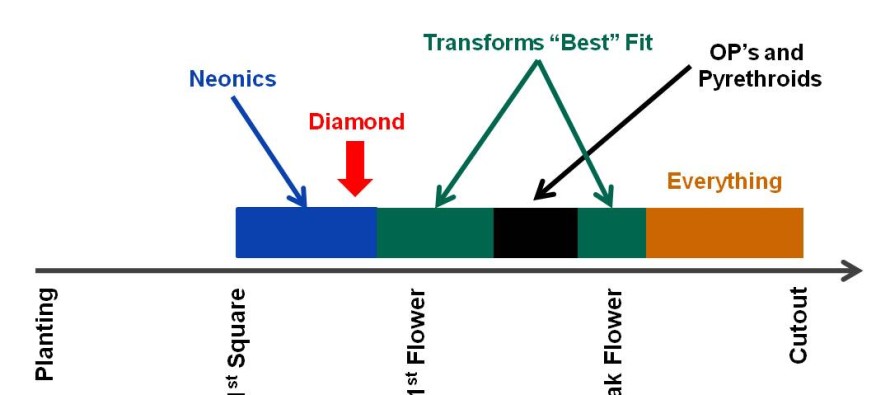Tarnished Plant Bug Nymphs Showing Up in Pre-Bloom Cotton

The tarnished plant bug calls have started to come in on small cotton already. In some cases, consultants and growers are finding nymphs on very young cotton with only 1-2 squares. Similarly, some are reporting plant bug flagged terminals in pre-square cotton. We rarely have to spray pre-square cotton for plant bugs, but our threshold is 1 flagged plant per 10 row feet with bugs present. Although tarnished plant bugs are our most important and most consistent pest of cotton in the Delta, we usually don’t start finding nymphs until closer to first flower.
With people finding nymphs already, the questions have started about when to use Diamond. As most of you know, we have been recommending a Diamond application sometime between the third week of squaring and first flower. Our research showed a yield advantage of anywhere from 100 to 300 lbs of lint per acre depending on the level of pressure in the Delta. The timing should coincide with peak emergence of adults migrating into the field so that the Diamond is out there when the eggs are laid and the nymphs hatch.
With that being said, it is possible to put that application out too early and lose some of the residual before the big movement occurs. Cotton with 1-2 small squares is definitely too early and a better timing would be in about 10 days to 2 weeks. During the early squaring stages it is best to manage plant bugs with some of the other insecticides available.
In the Hill Region of the state plant bug pressure is generally much lower and the benefits of early Diamond applications have not been thoroughly tested. However, in 2013 we saw very high plant bug pressure in parts of this region and square retention was marginal going into bloom. If you are in the Hill Region, monitor adult plant bug numbers closely and make the decision based on adult numbers. If you are reaching and exceeding threshold during the third week of squaring/first bloom you may benefit from this application.
The neonicotinoids are probably the product of choice at this time. Imidacloprid based products are probably the most common because of price, but Centric may be a better choice when nymphs are present because it tends to provide better control than imidacloprid. Transform is another option but I would prefer to see it go out a little later in the squaring period as we get closer to first flower. The best timing in my opinion is immediately after the first Diamond application. This will kind of give the bugs a “1-2 punch” and get us into flowering as clean as possible.
The one thing to remember in young cotton is that it is difficult to evaluate the performance of any insecticide. At this time of year, adults are likely to be constantly re-infesting fields. As a result, you may spray today and kill a large percentage of the bugs in the field. However, you may find twice as many plant bugs when you come back to that field 3-4 days later. This is not necessarily a case of an insecticide failure; it is most likely new adults that have moved into the field after the application. Because of that, monitoring first position square retention on the top 3 nodes is very important. As long as you are able to maintain greater than 80% square retention, the insecticides are doing what we need them to do.
In any case, it is best develop an insecticide use strategy now for the rest of the season. It may change over the season, but you will find that having a general plan in place now will help reduce some of the stress over what to use later. A general use strategy that we came up with based on our research is shown below, but it may need to be adjusted to fit specific situations. If you do think that you have had a failure with an insecticide, feel free to give one of us a call and try not to go back with the same chemistry.





Let me tell You a sad story ! There are no comments yet, but You can be first one to comment this article.
Write a comment